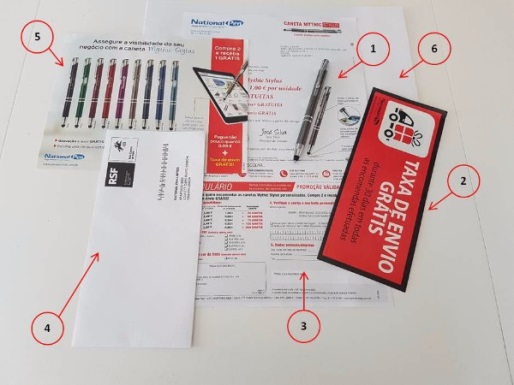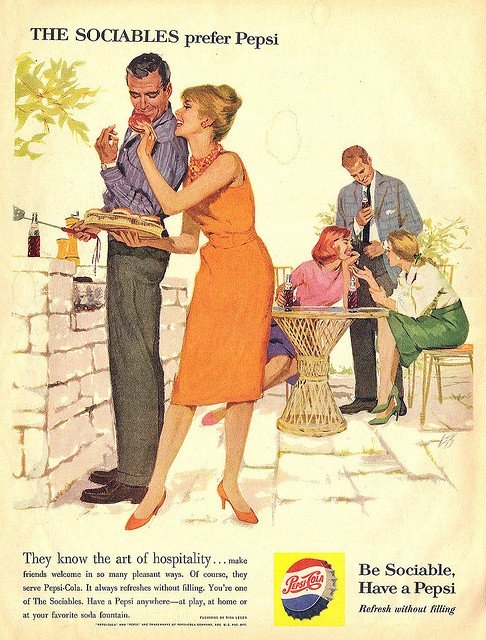
The well- known metaphor ‘Standing on the shoulders of giants’ has been in common use since the 12th century and is attributed to Bernard of Chartres, a prominent French scholar and philosopher of the time. The idea is that we discover truths by learning from and building upon previous learning and discoveries.
Though centuries old, the concept has not lost its prominence, nor has its meaning diminished. Quoting the famous 17th century British scientist, Sir Isaac Newton, Britain’s £2 coin has the words inscribed around its edge.
The famous contemporary British scientist, Stephen Hawking wrote a book in 2002 called On the Shoulders of Giants. The Great Works of Physics and Astronomy. In 2017 he said, “Each generation stands on the shoulders of those who have gone before them, just as I did as a young PhD student in Cambridge, inspired by the work of Isaac Newton, James Clerk Maxwell and Albert Einstein.”
We couldn’t climb aboard a passenger jet in Hong Kong and be in London thirteen hours later if it wasn’t for the crude and sometimes fatal attempts to fly by the Wright Brothers and other early aviation pioneers.
This is true of so many things we take for granted today. Even people of our grandparents’ generation couldn’t have imagined a world with personal computers, smart phones, space travel, social media and all the other trappings of modern living.
However, as always, there are traps. Considering the number and breadth of all those giant shoulders out there, some allegedly highly skilled business people were clearly looking behind and not ahead. Some attempts at interpreting the future have been frighteningly inept.
The path of progress is not always smooth
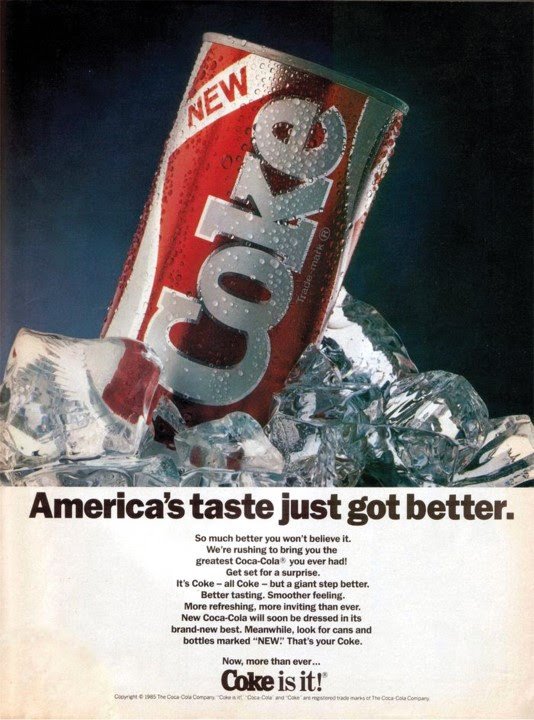
1. New Coke, the biggest blunder of them all?
Back in the 1980s, the two biggest cola brands, Coke and Pepsi, were in a state of marketing warfare. The competition between them was ferocious. At the time, Pepsi’s mission statement was boldly and simply expressed. The words ‘Kill Coke’ appeared on walls and desk tops throughout the company, leaving its employees in no doubt about their main objective.
What went on behind the scenes can only be imagined. Their public battles were fought in the magazine, TV and billboard campaigns on which both companies splashed tens of millions of dollars.
In 1985, Coke blinked. Pepsi was running a campaign that claimed more people preferred the taste of their product over Coke in a series of blind taste tests. In a panic, Coke hastily introduced New Coke with a new taste that was meant to challenge Pepsi’s claim.
But Coke consumers disliked the new taste and objected to anyone tampering with theirfavourite soft drink, which they likened to trampling on the American flag. The push back was so intense, Coke withdrew the new product and reintroduced the old product which they renamed Coke Classic.
New Coke survived for only four months and cost the company millions in wasted product development, packaging, distribution and advertising. What can’t be calculated is the damage to its reputation.
2. Fiat’s Spanish love affair
As a promotion campaign, it must have seemed like a sure winner. The challenge was for Fiat to attract more female buyers and, so the marketing team thought, what better way to tempt them than with a love letter.
It was perhaps due to lack of diversity in Fiat’s marketing department that this idea ever made it through the door. This was 1994, when almost all senior management jobs in the auto industry were held by men, many of whom had come up through the ranks from engineering or sales. A woman would have immediately seen that what the men thought was a little harmless flirting could actually backfire in a big way.
Unfazed, the company posted 50,000 personalised pink letters to women inviting them to indulge in “a little adventure”. Building relentlessly on its theme, the letter went on, “I only have to be with you for a few minutes and, even if it doesn’t work out between us, I promise you won’t forget our experience.”
There was no indication of the sender’s identity as Fiat intended to follow this teasing note a few days later with a second letter suggesting a test drive.
The impact was immediate. Fearing that a stalker was hounding them, dozens of women rushed to the police. The media of course headlined the story and, humiliated, Fiat frantically scrambled to stop the campaign and apologize to everyone who had been intimidated.
The company was fined and ordered to pay compensation to a woman who took them to court for causing her distress.
3. Is the motor industry more gaffe-prone than most?
Fiat’s harsh lesson in marketing to women is not the only car campaign to bring red faces rather than riches to its perpetrator.
Back in 1955, Ford carried out a major research study among car buyers to determine which features they wanted most in a new car. This was the first study of its size and promised to give Ford a major edge over its competitors.
In 1956, they began a year-long teaser campaign for the new brand, called Edsel, named after founder Henry Ford’s son, Edsel Bryant Ford. The American people were promised their ideal car of the future, based on what they had told the researchers.
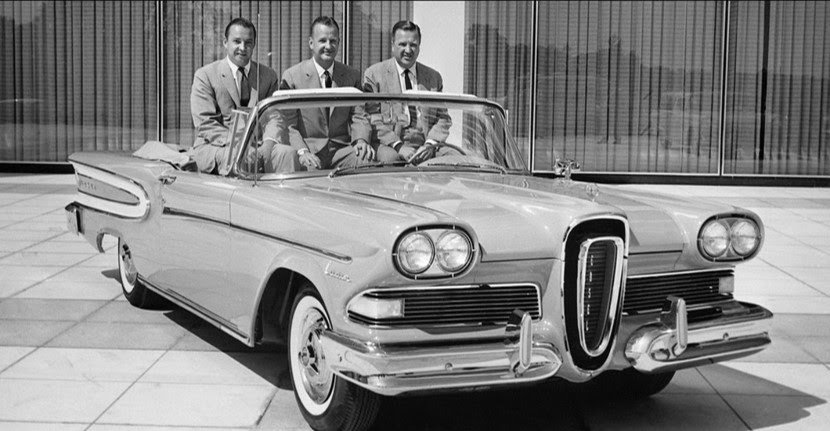
On 4 September 1957, called ‘E Day’ by Ford, the Edsel was officially launched. The problems became obvious within days. Poor design and manufacturing quality were the first drawbacks, followed closely by resistance to the price.
The car was undeniably ugly. In the front, its oversize vertical radiator resembled a mouth frozen in mid-scream. On many of the eighteen models, the body appeared flabby and cheaply adorned.
Paying between $2,500 and $3,800 when regular Fords were much cheaper made no sense to consumers, especially as the world was entering a recession. Three years and $400 million later, Ford finally laid the Edsel to rest.
Its legacy, however, lives on. Today, a rare Edsel convertible is worth around $50,000 if you can find one. Also, the Edsel saga survives as a case study in business schools, where learned professors will tell you that part of the Edsel’s problem is that Ford executives ignored large parts of their own research.
Had they discovered the value of communicating honestly with their customers, the Edsel idea would probably have died at birth.
A patchy performance.
Ford stumbled again many years later when introducing the Pinto into Brazil. In English the name means a horse with a coat patched in black or brown and white. In Portuguese, the language of Brazil, it’s a slang term for male genitals.
No, no to the Nano.
Even the noblest motives can amount to nothing as Tata discovered when they launched the Nano in India. Billed as the cheapest car available, proud Indian consumers avoided it in their millions. In a society where a car is a powerful symbol of wealth and status, not a commodity, nobody wanted to boast that all they could afford was a Nano.
4. The baby food botch ups.
Two companies, Nestlé and Gerber, were punished by their failure to fully understand the challenges of communicating to people in the developing world, many of whom are illiterate.
Nestlé had been marketing milk-based baby food since the late 1800s. When they decided to expand into Africa and other developing countries in the 1970s, they successfully convinced mothers that their formula was better for their babies than breast milk. The powdered infant formula could be stored without refrigeration and was simply mixed with water and fed to the baby from a bottle.
What the company didn’t understand is that many of the population were illiterate. This, combined with extreme poverty, led to mothers mixing inadequate amounts of powder, so of course their babies suffered from malnourishment.
Another problem was that many mothers had access only to contaminated drinking water leading to serious illnesses which their undernourished babies were often unable to survive.
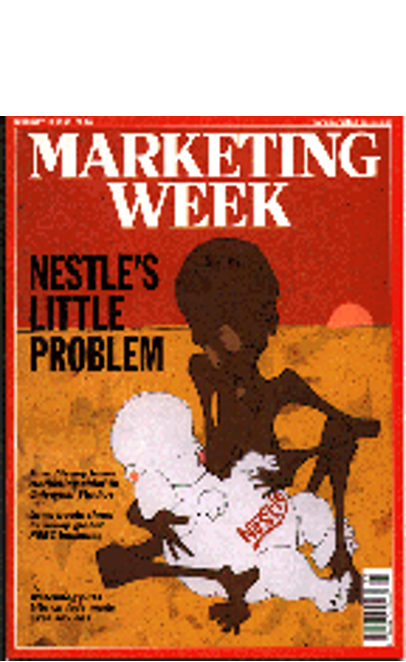
All these factors battered Nestlé’s reputation so much that a US boycott of the company’s baby formula soon spread to Europe and beyond and, in 1977, the company was known as ‘The Baby Killer’.
Gerber faced a slightly different problem when they began selling in Africa. Their product, sealed in glass jars, didn’t require mixing but was spooned into the baby’s mouth directly from the jar.
A couple of problems emerged, however, with this convenient and hygienic packaging. The label bore an illustration of a pretty, healthy looking white baby in countries where Caucasians were seldom encountered. More damaging, though, was that in communities which suffer from high levels of illiteracy, the picture on the pack usually illustrates the ingredients.
5. A bold show of confidence ends in embarrassment
In 2006, a company called LifeLock began a daring advertising campaign to dramatically demonstrate the effectiveness of its product. The company markets data protection services that they guarantee will protect their customers’ sensitive information against unauthorized access by thieves and hackers.
So confident were they in their invincibility, they placed advertisements reading: “My name is Todd Davis. My social security number is 457-55-5462.” At the time, Todd Davis was the company’s CEO and the social security number was his own. The idea was that even with his name and social security number, hackers could not steal his identity.
One year later, LifeLock’s security system was breached and Davis’ identity was stolen and used to obtain a loan of $500. Four months later, it was stolen again and used to run up a $2,500 phone bill. By the time the company fixed the breach in 2008, his identity had been used thirteen times.
This disaster was one of several questionable events in the company’s history. One of its founding partners spent time in jail over a gambling debt, was banned for life from the credit repair industry and allegedly spent $150,000 on a credit card he had ordered in his father’s name.
In 2008 LifeLock was sued for issuing false fraud alerts on clients’ accounts and, in 2010 was fined $12 million for deceptive advertising.
In December 2015, the company was fined $100 million by the Federal Trade Commission for contravening a previous court order that requires the company to secure its clients confidential information and refrain from deceptive advertising.
Symantec acquired LifeLock in November 2016. Todd Davis is no longer the CEO.
When you stand on the shoulders of giants, making sure you’re looking in the right direction
What is so useful about observing the behaviour of other businesses is that, whether they succeed beyond expectation or plunge like a stone into a lake, there are always lessons to be learned.
It needs the observer to admit that, as human beings, we all face the competing influences of ego, common sense and experience. Our mistake is to push for instant gratification of ambition and to take leadership without responsibility.
It is such errors that lead to disaster
If you liked, then please subscribe to our YouTube Channel for video content. You can also find us on Twitter, Facebook, Instagram and Linkedin.

